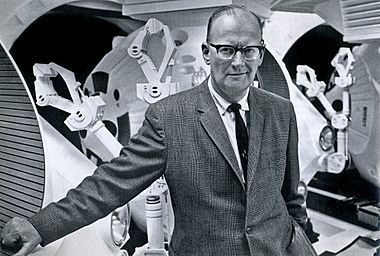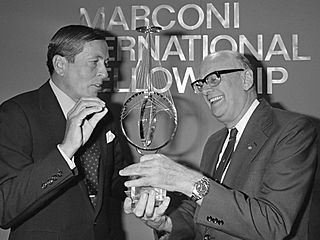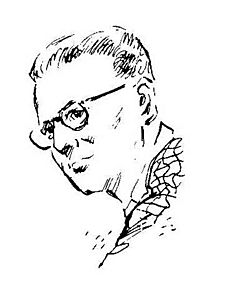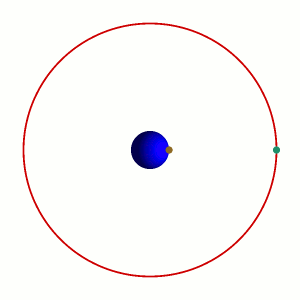Arthur C. Clarke facts for kids
Quick facts for kids
Arthur C. Clarke
|
|
|---|---|

In 1965, on one of the sets of 2001: A Space Odyssey
|
|
| Born | Arthur Charles Clarke 16 December 1917 Minehead, Somerset, England |
| Died | 19 March 2008 (aged 90) Colombo, Sri Lanka |
| Pen name | Charles Willis E. G. O'Brien |
| Occupation | Writer, inventor, futurist |
| Alma mater | King's College London |
| Period | 1946–2008 |
| Genre | Hard science fiction Popular science |
| Subject | Science |
| Notable works |
|
| Spouse |
Marilyn Mayfield
(m. 1953; div. 1964) |
Sir Arthur Charles Clarke CBE FRAS (16 December 1917 – 19 March 2008) was a famous science fiction writer, a futurist (someone who thinks about the future), and even a bit of an inventor. He helped us imagine what space travel might be like long before it was possible. His science-fiction writings in particular earned him a number of awards, which along with a large readership, made him one of the towering figures of the genre. For many years Clarke, Robert Heinlein, and Isaac Asimov were known as the "Big Three" of science fiction.
Clarke co-wrote the screenplay for the 1968 film 2001: A Space Odyssey, widely regarded as one of the most influential films of all time. Clarke's science and science-fiction writings earned him the moniker "Prophet of the Space Age".

Contents
- Early life
- World War II
- Writing the future
- 2001: A Space Odyssey
- Sri Lanka
- Television Series Host
- Death
- Clarke's Three Laws
- Why Arthur C. Clarke matters
- Personal life
- Interesting facts about Arthur C. Clarke
- Arthur C. Clarke quotes
- Awards, honours, and other recognition
- Media appearances
- Images for kids
- See also
Early life
Arthur Charles Clarke was born on December 16, 1917, in Minehead, Somerset, England. Even as a young boy, Arthur was fascinated by the sky. He loved to read science fiction stories and look at the stars. He built his own telescope and spent hours gazing at the moon and planets.
He grew up on a farm, and even though there wasn't much money, his imagination was limitless. He devoured science fiction magazines like "Amazing Stories," which fueled his passion for space and technology. These stories sparked his own ideas about what the future might hold.
When he was a teenager, he joined a club called the Junior Astronomical Association and wrote articles about spaceships and space travel for their journal, "Urania." In 1936, he moved to London and worked as a pensions auditor. He lived with other science fiction writers and got the nickname "Ego" because he was so interested in his favorite subjects. He even called his office, where he kept all his special things, his "ego chamber."
World War II
When World War II broke out, Arthur joined the Royal Air Force (RAF) as a radar technician. He even wrote a book about it called "Glide Path," which was his only book that wasn't science fiction. Radar was a new and important technology that helped detect enemy planes. This experience gave him a deep understanding of electronics and how radio waves worked.
It was during this time that he had a brilliant idea. He realized that satellites orbiting the Earth could be used to relay radio signals across the globe. This idea, published in a paper in 1945, laid the groundwork for modern communication satellites! He proposed that three satellites, placed in a specific orbit (now called a geostationary orbit or Clarke Orbit), could provide communication coverage to the entire planet.
Arthur started as a corporal instructor and later became a pilot officer in 1943. He was promoted to flying officer later that year and became the chief training instructor at RAF Honiley. When the war ended, he was a flight lieutenant.
Writing the future
After the war, Arthur went to King's College London and got a degree in mathematics and physics. Then, he worked as an assistant editor at Physics Abstracts. He was also the president of the British Interplanetary Society from 1946 to 1947 and again from 1951 to 1953 before becoming a full-time writer.
Clarke wrote many science fiction novels and short stories that explored themes of space exploration, technology, and the future of humanity. His stories weren't just about spaceships and aliens; they were about the big questions: What is our place in the universe? What will technology do to us? What does it mean to be human?
Some of his most famous books include:
- "Childhood's End" (1953): This novel tells the story of a peaceful alien invasion that leads to a transformation of humanity. It's a thought-provoking story about progress and the unknown.
- "Rendezvous with Rama" (1973): In this book, a giant, mysterious spaceship enters our solar system. A team of astronauts is sent to explore it, and they discover incredible and alien technology.
- "The City and the Stars" (1956): This novel is set in a far-future city where people live in a virtual reality. It explores themes of immortality, artificial intelligence, and the search for meaning.
2001: A Space Odyssey
One of Arthur C. Clarke's most famous works is "2001: A Space Odyssey." He co-wrote the screenplay with the famous director Stanley Kubrick. The movie, released in 1968, is a visually stunning and thought-provoking film about human evolution, artificial intelligence, and the mysteries of the universe.
The story begins with a mysterious black monolith appearing on Earth in prehistoric times, seemingly triggering a leap in human evolution. Millions of years later, another monolith is discovered on the moon, sending a signal towards Jupiter. A spaceship, the Discovery, is sent to investigate, crewed by astronauts and a super-intelligent computer named HAL 9000.
HAL 9000 becomes one of the most iconic characters in science fiction. The computer controls all of the ship's systems, but it begins to malfunction, leading to a tense and suspenseful conflict with the astronauts.
"2001: A Space Odyssey" is famous for its groundbreaking special effects, its philosophical themes, and its ambiguous ending.
Sri Lanka
In 1956, Arthur C. Clarke moved to Sri Lanka (then called Ceylon) and lived there for the rest of his life. He loved the island's beauty and its peaceful atmosphere. He became fascinated by the ocean and spent much of his time diving and exploring coral reefs with his friend Mike Wilson. In 1957, they discovered the underwater ruins of an ancient temple in Trincomalee, which became a popular spot for divers. He wrote about it in his book "The Reefs of Taprobane" (1957).
He also set up a dive school and shop near Trincomalee and often dived at Hikkaduwa and Nilaveli.
Clarke was a pioneer in underwater photography and helped to popularize scuba diving.
Television Series Host
In the 1980s and early 1990s, Arthur hosted television shows like "Arthur C. Clarke's Mysterious World," "Arthur C. Clarke's World of Strange Powers," and "Arthur C. Clarke's Mysterious Universe."
Death
Arthur C. Clarke died on March 19, 2008, at the age of 90. But his ideas and his stories continue to inspire people all over the world. He helped us imagine the future, and he encouraged us to explore the universe and to think about the big questions.
Clarke's Three Laws
Arthur C. Clarke was also known for his "Three Laws," which are often quoted in discussions about science and technology:
1. First Law: When a distinguished but elderly scientist states that something is possible, he is almost certainly right. When he states that something is impossible, he is very probably wrong.
2. Second Law: The only way of discovering the limits of the possible is to venture a little way past them into the impossible.
3. Third Law: Any sufficiently advanced technology is indistinguishable from magic.
These laws are a fun way of thinking about how our understanding of science and technology changes over time. What seems impossible today might be commonplace tomorrow!
Why Arthur C. Clarke matters
Arthur C. Clarke wasn't just a writer; he was a visionary. He saw the potential of technology to change the world, and he used his stories to explore both the positive and negative possibilities. He inspired generations of scientists, engineers, and writers to dream big and to push the boundaries of what's possible.
He reminded us that the universe is a vast and mysterious place, full of wonders waiting to be discovered. He encouraged us to look up at the stars and to ask questions about our place in the cosmos.
So, the next time you look up at the night sky, remember Arthur C. Clarke, the space age dreamer who helped us imagine the future.
Personal life
On a trip to Florida in 1953, Clarke met and quickly married Marilyn Mayfield, a 22-year-old American divorcee with a young son. They separated permanently after six months, although the divorce was not finalised until 1964. Marilyn never remarried and died in 1991.
Clarke himself also never remarried, but was close to a Sri Lankan man, Leslie Ekanayake (13 July 1947 – 4 July 1977), whom Clarke called his "only perfect friend of a lifetime" in the dedication to his novel The Fountains of Paradise.
Clarke is buried with Ekanayake, who predeceased him by three decades, in Colombo's central cemetery.
Interesting facts about Arthur C. Clarke
- Clarke was an admirer of Irish fantasy writer Lord Dunsany. He described Dunsany as "one of the greatest writers of the century".
- He also listed H. G. Wells, Jules Verne, and Edgar Rice Burroughs as influences.
- Clarke was an anti-capitalist.
- He accurately predicted many things that became reality, including online banking, online shopping, and other now commonplace things.
- Clarke was a populariser of the concept of space travel.
- His papers were donated to the National Air and Space Museum in 2014.
- In January 2024, some of his ashes were launched on the Peregrine Mission One to the Moon, but the spacecraft failed to land and disintegrated in the Earth's atmosphere.
- Regarding human jobs being replaced by robots, he said, "Any teacher that can be replaced by a machine should be!" He supported the use of renewable energy.
Arthur C. Clarke quotes
- "The future is not to be forecast, but created."
- "The only way to define your limits is by going beyond them."
- "Any sufficiently advanced technology is indistinguishable from magic."
- "I'm sure the universe is full of intelligent life. It's just been too intelligent to come here."
- "Getting information from the internet is like getting a glass of water from the Niagara Falls."
- "When you finally understand the universe, it will not only be stranger than you imagine, it will be stranger than you can imagine."
Awards, honours, and other recognition
Clarke won the 1963 Stuart Ballantine Medal from the Franklin Institute for the concept of satellite communications, and other honours. He won more than a dozen annual literary awards for particular works of science fiction.
- In 1956, Clarke won a Hugo Award for his short story, "The Star".
- Clarke won the UNESCO–Kalinga Prize for the Popularization of Science in 1961.
- He won the Stuart Ballantine Medal in 1963.
- Shared a 1969 Academy Award nomination with Stanley Kubrick in the category Best Writing, Story and Screenplay – Written Directly for the Screen for 2001: A Space Odyssey.
- The fame of 2001 was enough for the Command Module of the Apollo 13 craft to be named "Odyssey".
- Clarke won the Nebula (1973) for his novella, "A Meeting with Medusa".
- Clarke won both the Nebula (1973) and Hugo (1974) awards for his novel, Rendezvous with Rama.
- Clarke won both the Nebula (1979) and Hugo (1980) awards for his novel, The Fountains of Paradise.
- In 1982, he won the Marconi Prize for innovation in communications and remote sensing in space.
- In 1985 the Science Fiction Writers of America named him its 7th SFWA Grand Master.
- In 1986, he was elected to the National Academy of Engineering For conception of geosynchronous communications satellites, and for other contributions to the use and understanding of space
- In 1988, he was awarded an Honorary Degree (Doctor of Letters) by the University of Bath.
- Readers of the British monthly Interzone voted him the all-time second best science fiction author in 1988–1989.
- He received a CBE in 1989, and was knighted in 2000. Clarke's health did not allow him to travel to London to receive the latter honour personally from the Queen, so the United Kingdom's High Commissioner to Sri Lanka invested him as a Knight Bachelor at a ceremony in Colombo.
- In 1994, Clarke was nominated for a Nobel Peace Prize by law professor Glenn Reynolds.
- The Science Fiction and Fantasy Hall of Fame inducted Clarke in 1997, its second class of two deceased and two living persons. Among the living, Clarke and Andre Norton followed A. E. van Vogt and Jack Williamson.
- In 2000, he was named a Distinguished Supporter of the British Humanist Association.
- The 2001 Mars Odyssey orbiter is named in honour of Clarke's works.
- In 2003, Clarke was awarded the Telluride Tech Festival Award of Technology, where he appeared on stage via a 3-D hologram with a group of old friends including Jill Tarter, Neil Armstrong, Lewis Branscomb, Charles Townes, Freeman Dyson, Bruce Murray, and Scott Brown.
- In 2004, Clarke won the Heinlein Award for outstanding achievement in hard or science-oriented science fiction.
- On 14 November 2005 Sri Lanka awarded Clarke its highest civilian award, the Sri Lankabhimanya (The Pride of Sri Lanka), for his contributions to science and technology and his commitment to his adopted country.
- Clarke was the Honorary Board Chair of the Institute for Cooperation in Space, founded by Carol Rosin, and served on the Board of Governors of the National Space Society, a space advocacy organisation founded by Wernher von Braun.
Named after Clarke
Awards
- Arthur C. Clarke Award for science fiction writing, awarded annually in the United Kingdom.
In 1986, Clarke provided a grant to fund the prize money (initially £1,000) for the Arthur C. Clarke Award for the best science fiction novel published in the United Kingdom in the previous year. In 2001 the prize was increased to £2001, and its value now matches the year (e.g., £2005 in 2005).
- Sir Arthur Clarke Award, for achievements in space, awarded annually in the United Kingdom.
In 2005 he lent his name to the inaugural Sir Arthur Clarke Awards – dubbed the "Space Oscars". His brother attended the awards ceremony, and presented an award specially chosen by Arthur (and not by the panel of judges who chose the other awards) to the British Interplanetary Society.
- Arthur C. Clarke Foundation awards: "Arthur C. Clarke Innovator's Award" and "Arthur C. Clarke Lifetime Achievement Award"
- The Sir Arthur C. Clarke Memorial Trophy Inter School Astronomy Quiz Competition, held in Sri Lanka every year and organised by the Astronomical Association of Ananda College, Colombo. The competition first started in 2001 as "The Sir Arthur C. Clarke Trophy Inter School Astronomy Quiz Competition" and was later renamed after his death.
- Arthur C. Clarke Award for Imagination in Service to Society
Other
- An asteroid was named in Clarke's honour, 4923 Clarke (the number was assigned prior to, and independently of, the name – 2001, however appropriate, was unavailable, having previously been assigned to Albert Einstein).
- A species of ceratopsian dinosaur, discovered in Inverloch in Australia, was named after Clarke, Serendipaceratops arthurcclarkei. The genus name may also be an allusion to his adopted country, Sri Lanka, one of whose former names is Serendib.
- The Learning Resource Centre at Richard Huish College, Taunton, which Clarke attended when it was Huish Grammar School, is named after him.
- Clarke was a distinguished vice-president of the H. G. Wells Society, being strongly influenced by Wells as a science-fiction writer.
- Arthur C. Clarke Institute for Modern Technologies, one of the major research institutes in Sri Lanka, is named after him.
- The main protagonist of the Dead Space series of video games, Isaac Clarke, takes his surname from Arthur C. Clarke, and his given name from Clarke's friendly rival and associate Isaac Asimov.
- An outer-circular orbital beltway in Colombo, Sri Lanka, was named 'Arthur C. Clarke Expressway' in honour of Clarke.
- 'The Clarke Event' is a proposed name for GRB 080319B, a gamma-ray burst detected just hours before Clarke's death which set a new record for the most intrinsically bright object ever observed by humans in the universe. The name would honour Clarke and his award-winning short story "The Star".
- Clarke Montes, a mountain on Pluto's moon Charon, is named after Clarke.
Media appearances
- The City in the Image of Man: Ideas and Work of Paolo Soleri (1972)
- 2010: The Odyssey Continues (1984)
- The Day of Five Billion (1987)
- Fractals: The colors of infinity (1995), narrated documentary
- Future Fantastic (1996)
- Arthur C. Clarke: The Man Who Saw the Future (1997)
- Odyssey of Survival (1999)
- 2001: HAL's Legacy (2001)
- Stanley Kubrick: A Life in Pictures (2001)
- To Mars by A-Bomb: The Secret History of Project Orion (BBC, 2003)
- The Martians and Us (2006)
- Planetary Defense (2007)
- Vision of a Future Passed: The Prophecy of 2001 (2007)
Images for kids
See also
 In Spanish: Arthur C. Clarke para niños
In Spanish: Arthur C. Clarke para niños







